Legal and Ethical Decision-Making in Person-Centered Care: An Analysis
VerifiedAdded on 2021/06/17
|11
|3368
|27
Essay
AI Summary
This essay provides a comprehensive analysis of legal and ethical decision-making within the context of person-centered care, using a case study involving a patient, Dawn, who has suffered a massive stroke and is in a vegetative state. The essay explores the complexities of a "do not resuscitate" scenario, highlighting the conflicting viewpoints of the patient's family members, the nurse, and the legal and ethical considerations. It delves into crucial legal aspects such as informed consent, confidentiality, and patient autonomy, emphasizing the importance of respecting patient rights and ensuring that decisions align with legal stipulations. Furthermore, the essay meticulously examines key ethical principles, including nonmaleficence, beneficence, justice, and respect for autonomy, providing a nuanced understanding of how these principles guide healthcare professionals in making difficult choices. The essay ultimately concludes by reiterating the importance of balancing legal requirements with ethical considerations, advocating for patient-centered care that respects individual values and promotes the well-being of all parties involved.
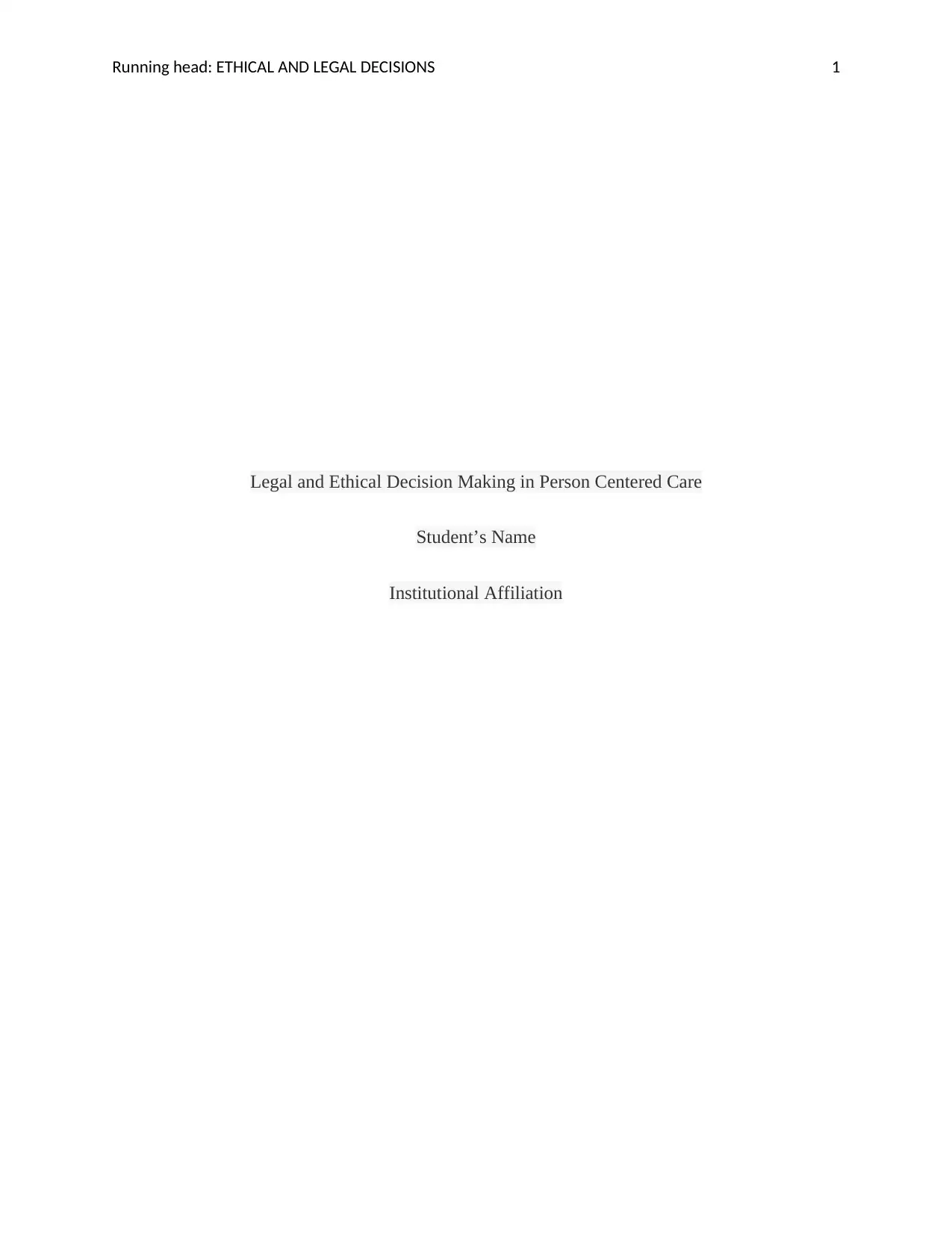
Running head: ETHICAL AND LEGAL DECISIONS 1
Legal and Ethical Decision Making in Person Centered Care
Student’s Name
Institutional Affiliation
Legal and Ethical Decision Making in Person Centered Care
Student’s Name
Institutional Affiliation
Paraphrase This Document
Need a fresh take? Get an instant paraphrase of this document with our AI Paraphraser
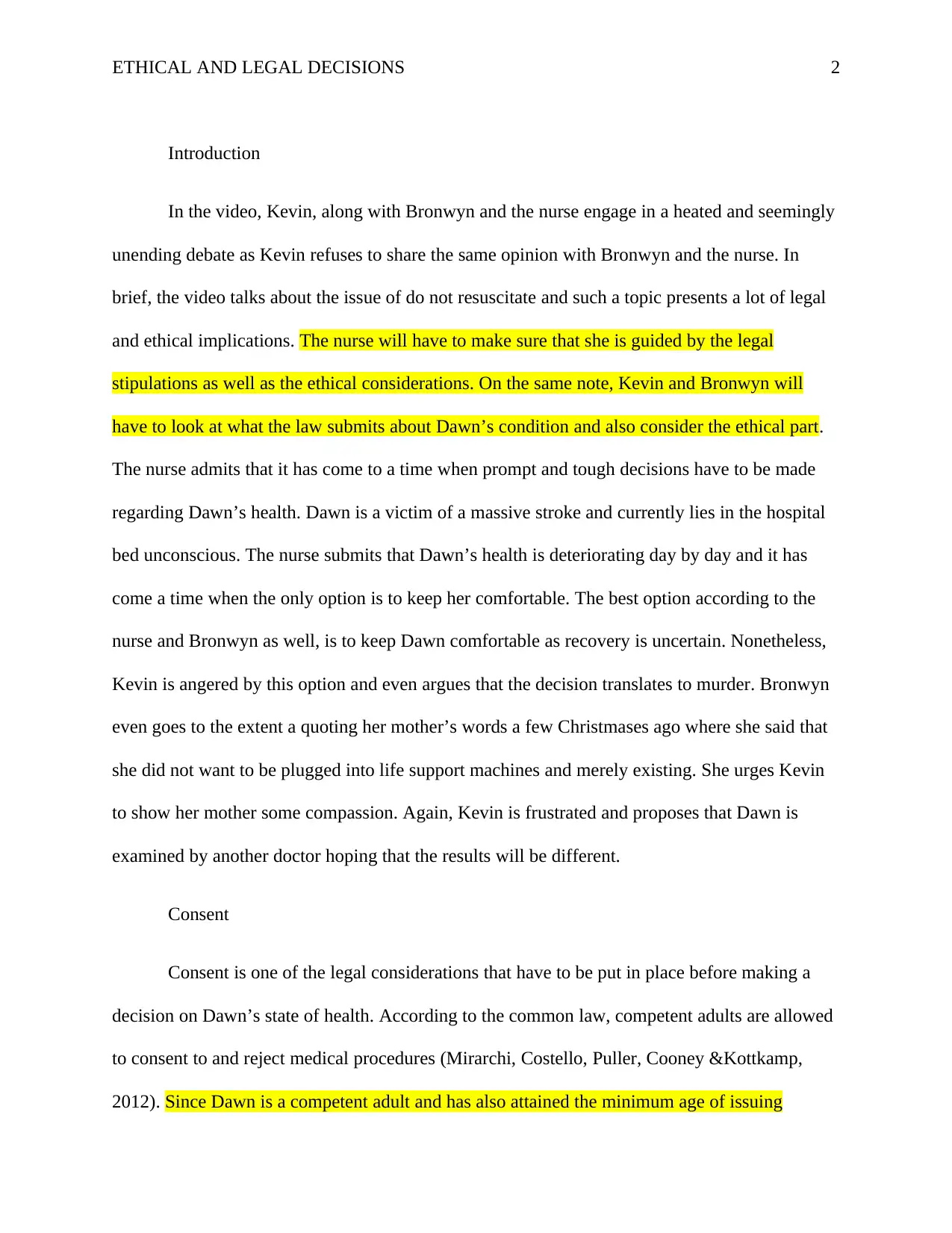
ETHICAL AND LEGAL DECISIONS 2
Introduction
In the video, Kevin, along with Bronwyn and the nurse engage in a heated and seemingly
unending debate as Kevin refuses to share the same opinion with Bronwyn and the nurse. In
brief, the video talks about the issue of do not resuscitate and such a topic presents a lot of legal
and ethical implications. The nurse will have to make sure that she is guided by the legal
stipulations as well as the ethical considerations. On the same note, Kevin and Bronwyn will
have to look at what the law submits about Dawn’s condition and also consider the ethical part.
The nurse admits that it has come to a time when prompt and tough decisions have to be made
regarding Dawn’s health. Dawn is a victim of a massive stroke and currently lies in the hospital
bed unconscious. The nurse submits that Dawn’s health is deteriorating day by day and it has
come a time when the only option is to keep her comfortable. The best option according to the
nurse and Bronwyn as well, is to keep Dawn comfortable as recovery is uncertain. Nonetheless,
Kevin is angered by this option and even argues that the decision translates to murder. Bronwyn
even goes to the extent a quoting her mother’s words a few Christmases ago where she said that
she did not want to be plugged into life support machines and merely existing. She urges Kevin
to show her mother some compassion. Again, Kevin is frustrated and proposes that Dawn is
examined by another doctor hoping that the results will be different.
Consent
Consent is one of the legal considerations that have to be put in place before making a
decision on Dawn’s state of health. According to the common law, competent adults are allowed
to consent to and reject medical procedures (Mirarchi, Costello, Puller, Cooney &Kottkamp,
2012). Since Dawn is a competent adult and has also attained the minimum age of issuing
Introduction
In the video, Kevin, along with Bronwyn and the nurse engage in a heated and seemingly
unending debate as Kevin refuses to share the same opinion with Bronwyn and the nurse. In
brief, the video talks about the issue of do not resuscitate and such a topic presents a lot of legal
and ethical implications. The nurse will have to make sure that she is guided by the legal
stipulations as well as the ethical considerations. On the same note, Kevin and Bronwyn will
have to look at what the law submits about Dawn’s condition and also consider the ethical part.
The nurse admits that it has come to a time when prompt and tough decisions have to be made
regarding Dawn’s health. Dawn is a victim of a massive stroke and currently lies in the hospital
bed unconscious. The nurse submits that Dawn’s health is deteriorating day by day and it has
come a time when the only option is to keep her comfortable. The best option according to the
nurse and Bronwyn as well, is to keep Dawn comfortable as recovery is uncertain. Nonetheless,
Kevin is angered by this option and even argues that the decision translates to murder. Bronwyn
even goes to the extent a quoting her mother’s words a few Christmases ago where she said that
she did not want to be plugged into life support machines and merely existing. She urges Kevin
to show her mother some compassion. Again, Kevin is frustrated and proposes that Dawn is
examined by another doctor hoping that the results will be different.
Consent
Consent is one of the legal considerations that have to be put in place before making a
decision on Dawn’s state of health. According to the common law, competent adults are allowed
to consent to and reject medical procedures (Mirarchi, Costello, Puller, Cooney &Kottkamp,
2012). Since Dawn is a competent adult and has also attained the minimum age of issuing
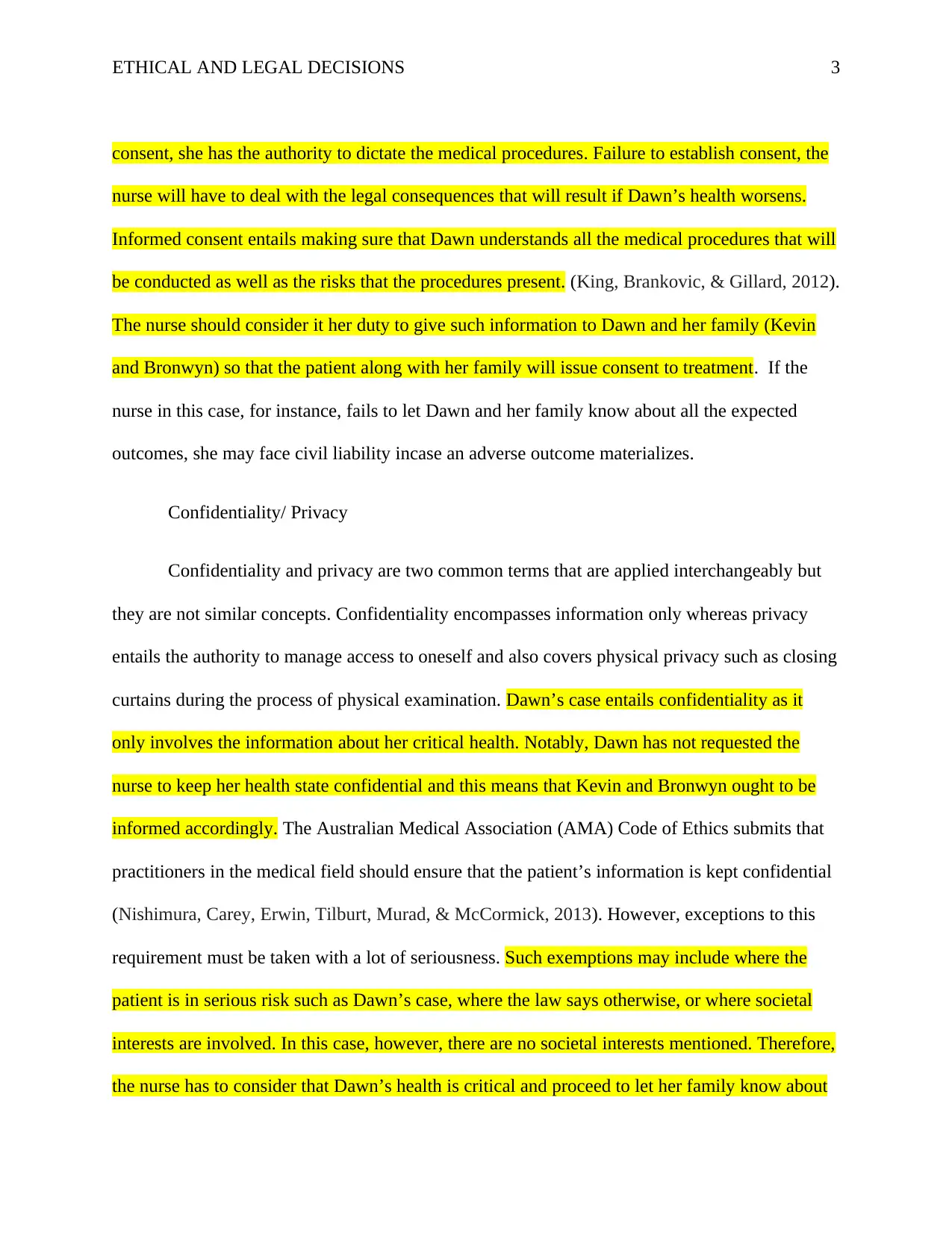
ETHICAL AND LEGAL DECISIONS 3
consent, she has the authority to dictate the medical procedures. Failure to establish consent, the
nurse will have to deal with the legal consequences that will result if Dawn’s health worsens.
Informed consent entails making sure that Dawn understands all the medical procedures that will
be conducted as well as the risks that the procedures present. (King, Brankovic, & Gillard, 2012).
The nurse should consider it her duty to give such information to Dawn and her family (Kevin
and Bronwyn) so that the patient along with her family will issue consent to treatment. If the
nurse in this case, for instance, fails to let Dawn and her family know about all the expected
outcomes, she may face civil liability incase an adverse outcome materializes.
Confidentiality/ Privacy
Confidentiality and privacy are two common terms that are applied interchangeably but
they are not similar concepts. Confidentiality encompasses information only whereas privacy
entails the authority to manage access to oneself and also covers physical privacy such as closing
curtains during the process of physical examination. Dawn’s case entails confidentiality as it
only involves the information about her critical health. Notably, Dawn has not requested the
nurse to keep her health state confidential and this means that Kevin and Bronwyn ought to be
informed accordingly. The Australian Medical Association (AMA) Code of Ethics submits that
practitioners in the medical field should ensure that the patient’s information is kept confidential
(Nishimura, Carey, Erwin, Tilburt, Murad, & McCormick, 2013). However, exceptions to this
requirement must be taken with a lot of seriousness. Such exemptions may include where the
patient is in serious risk such as Dawn’s case, where the law says otherwise, or where societal
interests are involved. In this case, however, there are no societal interests mentioned. Therefore,
the nurse has to consider that Dawn’s health is critical and proceed to let her family know about
consent, she has the authority to dictate the medical procedures. Failure to establish consent, the
nurse will have to deal with the legal consequences that will result if Dawn’s health worsens.
Informed consent entails making sure that Dawn understands all the medical procedures that will
be conducted as well as the risks that the procedures present. (King, Brankovic, & Gillard, 2012).
The nurse should consider it her duty to give such information to Dawn and her family (Kevin
and Bronwyn) so that the patient along with her family will issue consent to treatment. If the
nurse in this case, for instance, fails to let Dawn and her family know about all the expected
outcomes, she may face civil liability incase an adverse outcome materializes.
Confidentiality/ Privacy
Confidentiality and privacy are two common terms that are applied interchangeably but
they are not similar concepts. Confidentiality encompasses information only whereas privacy
entails the authority to manage access to oneself and also covers physical privacy such as closing
curtains during the process of physical examination. Dawn’s case entails confidentiality as it
only involves the information about her critical health. Notably, Dawn has not requested the
nurse to keep her health state confidential and this means that Kevin and Bronwyn ought to be
informed accordingly. The Australian Medical Association (AMA) Code of Ethics submits that
practitioners in the medical field should ensure that the patient’s information is kept confidential
(Nishimura, Carey, Erwin, Tilburt, Murad, & McCormick, 2013). However, exceptions to this
requirement must be taken with a lot of seriousness. Such exemptions may include where the
patient is in serious risk such as Dawn’s case, where the law says otherwise, or where societal
interests are involved. In this case, however, there are no societal interests mentioned. Therefore,
the nurse has to consider that Dawn’s health is critical and proceed to let her family know about
⊘ This is a preview!⊘
Do you want full access?
Subscribe today to unlock all pages.

Trusted by 1+ million students worldwide
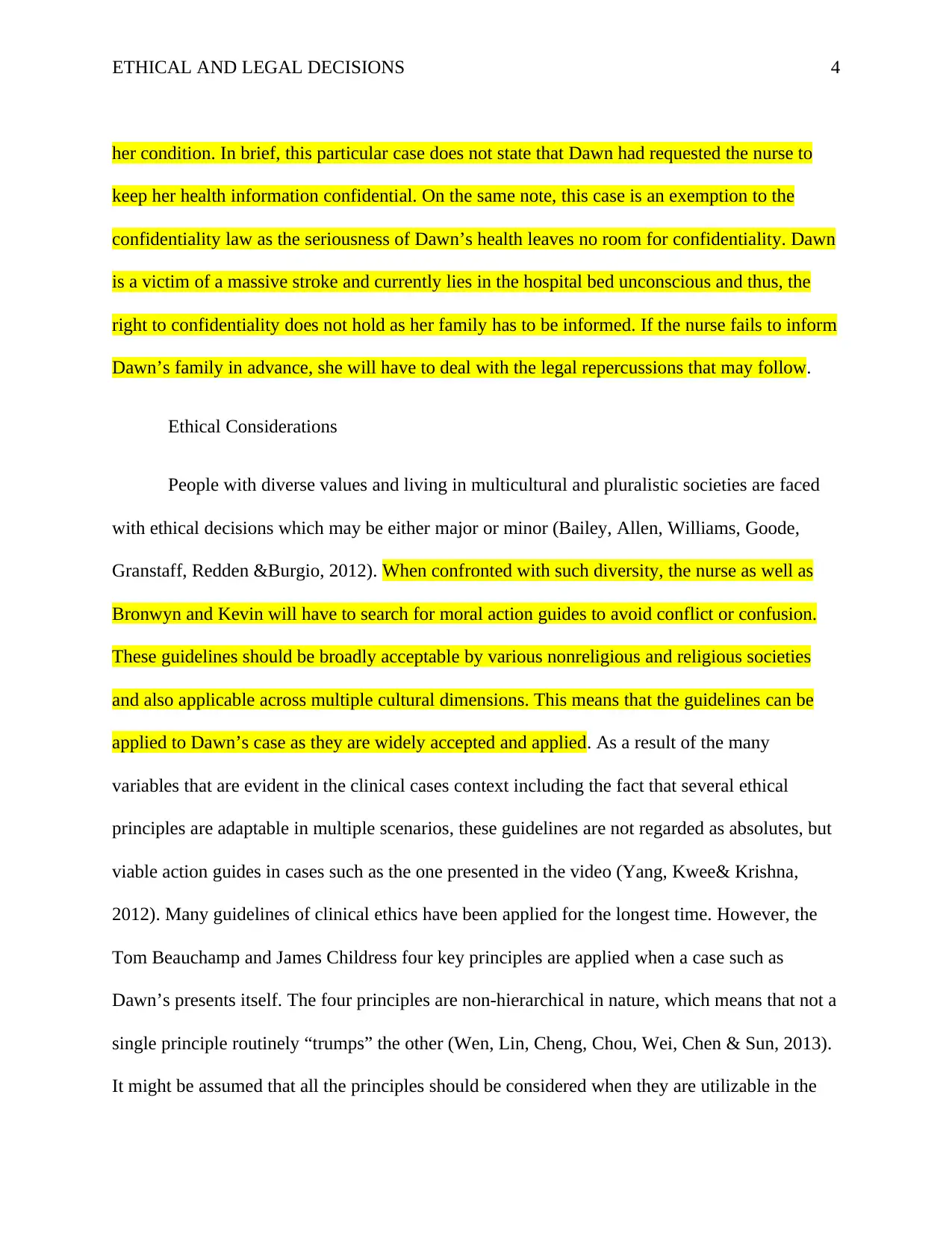
ETHICAL AND LEGAL DECISIONS 4
her condition. In brief, this particular case does not state that Dawn had requested the nurse to
keep her health information confidential. On the same note, this case is an exemption to the
confidentiality law as the seriousness of Dawn’s health leaves no room for confidentiality. Dawn
is a victim of a massive stroke and currently lies in the hospital bed unconscious and thus, the
right to confidentiality does not hold as her family has to be informed. If the nurse fails to inform
Dawn’s family in advance, she will have to deal with the legal repercussions that may follow.
Ethical Considerations
People with diverse values and living in multicultural and pluralistic societies are faced
with ethical decisions which may be either major or minor (Bailey, Allen, Williams, Goode,
Granstaff, Redden &Burgio, 2012). When confronted with such diversity, the nurse as well as
Bronwyn and Kevin will have to search for moral action guides to avoid conflict or confusion.
These guidelines should be broadly acceptable by various nonreligious and religious societies
and also applicable across multiple cultural dimensions. This means that the guidelines can be
applied to Dawn’s case as they are widely accepted and applied. As a result of the many
variables that are evident in the clinical cases context including the fact that several ethical
principles are adaptable in multiple scenarios, these guidelines are not regarded as absolutes, but
viable action guides in cases such as the one presented in the video (Yang, Kwee& Krishna,
2012). Many guidelines of clinical ethics have been applied for the longest time. However, the
Tom Beauchamp and James Childress four key principles are applied when a case such as
Dawn’s presents itself. The four principles are non-hierarchical in nature, which means that not a
single principle routinely “trumps” the other (Wen, Lin, Cheng, Chou, Wei, Chen & Sun, 2013).
It might be assumed that all the principles should be considered when they are utilizable in the
her condition. In brief, this particular case does not state that Dawn had requested the nurse to
keep her health information confidential. On the same note, this case is an exemption to the
confidentiality law as the seriousness of Dawn’s health leaves no room for confidentiality. Dawn
is a victim of a massive stroke and currently lies in the hospital bed unconscious and thus, the
right to confidentiality does not hold as her family has to be informed. If the nurse fails to inform
Dawn’s family in advance, she will have to deal with the legal repercussions that may follow.
Ethical Considerations
People with diverse values and living in multicultural and pluralistic societies are faced
with ethical decisions which may be either major or minor (Bailey, Allen, Williams, Goode,
Granstaff, Redden &Burgio, 2012). When confronted with such diversity, the nurse as well as
Bronwyn and Kevin will have to search for moral action guides to avoid conflict or confusion.
These guidelines should be broadly acceptable by various nonreligious and religious societies
and also applicable across multiple cultural dimensions. This means that the guidelines can be
applied to Dawn’s case as they are widely accepted and applied. As a result of the many
variables that are evident in the clinical cases context including the fact that several ethical
principles are adaptable in multiple scenarios, these guidelines are not regarded as absolutes, but
viable action guides in cases such as the one presented in the video (Yang, Kwee& Krishna,
2012). Many guidelines of clinical ethics have been applied for the longest time. However, the
Tom Beauchamp and James Childress four key principles are applied when a case such as
Dawn’s presents itself. The four principles are non-hierarchical in nature, which means that not a
single principle routinely “trumps” the other (Wen, Lin, Cheng, Chou, Wei, Chen & Sun, 2013).
It might be assumed that all the principles should be considered when they are utilizable in the
Paraphrase This Document
Need a fresh take? Get an instant paraphrase of this document with our AI Paraphraser
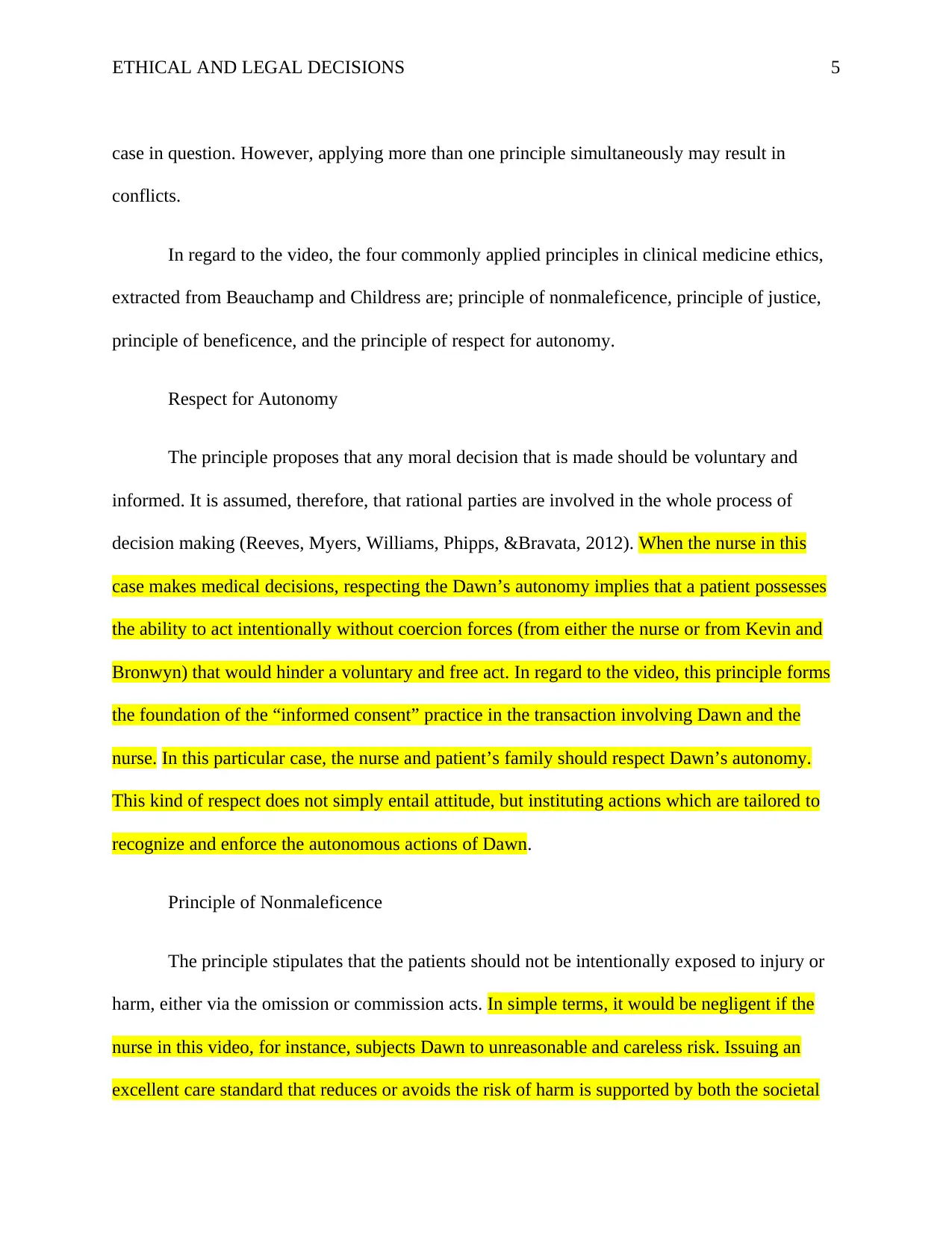
ETHICAL AND LEGAL DECISIONS 5
case in question. However, applying more than one principle simultaneously may result in
conflicts.
In regard to the video, the four commonly applied principles in clinical medicine ethics,
extracted from Beauchamp and Childress are; principle of nonmaleficence, principle of justice,
principle of beneficence, and the principle of respect for autonomy.
Respect for Autonomy
The principle proposes that any moral decision that is made should be voluntary and
informed. It is assumed, therefore, that rational parties are involved in the whole process of
decision making (Reeves, Myers, Williams, Phipps, &Bravata, 2012). When the nurse in this
case makes medical decisions, respecting the Dawn’s autonomy implies that a patient possesses
the ability to act intentionally without coercion forces (from either the nurse or from Kevin and
Bronwyn) that would hinder a voluntary and free act. In regard to the video, this principle forms
the foundation of the “informed consent” practice in the transaction involving Dawn and the
nurse. In this particular case, the nurse and patient’s family should respect Dawn’s autonomy.
This kind of respect does not simply entail attitude, but instituting actions which are tailored to
recognize and enforce the autonomous actions of Dawn.
Principle of Nonmaleficence
The principle stipulates that the patients should not be intentionally exposed to injury or
harm, either via the omission or commission acts. In simple terms, it would be negligent if the
nurse in this video, for instance, subjects Dawn to unreasonable and careless risk. Issuing an
excellent care standard that reduces or avoids the risk of harm is supported by both the societal
case in question. However, applying more than one principle simultaneously may result in
conflicts.
In regard to the video, the four commonly applied principles in clinical medicine ethics,
extracted from Beauchamp and Childress are; principle of nonmaleficence, principle of justice,
principle of beneficence, and the principle of respect for autonomy.
Respect for Autonomy
The principle proposes that any moral decision that is made should be voluntary and
informed. It is assumed, therefore, that rational parties are involved in the whole process of
decision making (Reeves, Myers, Williams, Phipps, &Bravata, 2012). When the nurse in this
case makes medical decisions, respecting the Dawn’s autonomy implies that a patient possesses
the ability to act intentionally without coercion forces (from either the nurse or from Kevin and
Bronwyn) that would hinder a voluntary and free act. In regard to the video, this principle forms
the foundation of the “informed consent” practice in the transaction involving Dawn and the
nurse. In this particular case, the nurse and patient’s family should respect Dawn’s autonomy.
This kind of respect does not simply entail attitude, but instituting actions which are tailored to
recognize and enforce the autonomous actions of Dawn.
Principle of Nonmaleficence
The principle stipulates that the patients should not be intentionally exposed to injury or
harm, either via the omission or commission acts. In simple terms, it would be negligent if the
nurse in this video, for instance, subjects Dawn to unreasonable and careless risk. Issuing an
excellent care standard that reduces or avoids the risk of harm is supported by both the societal
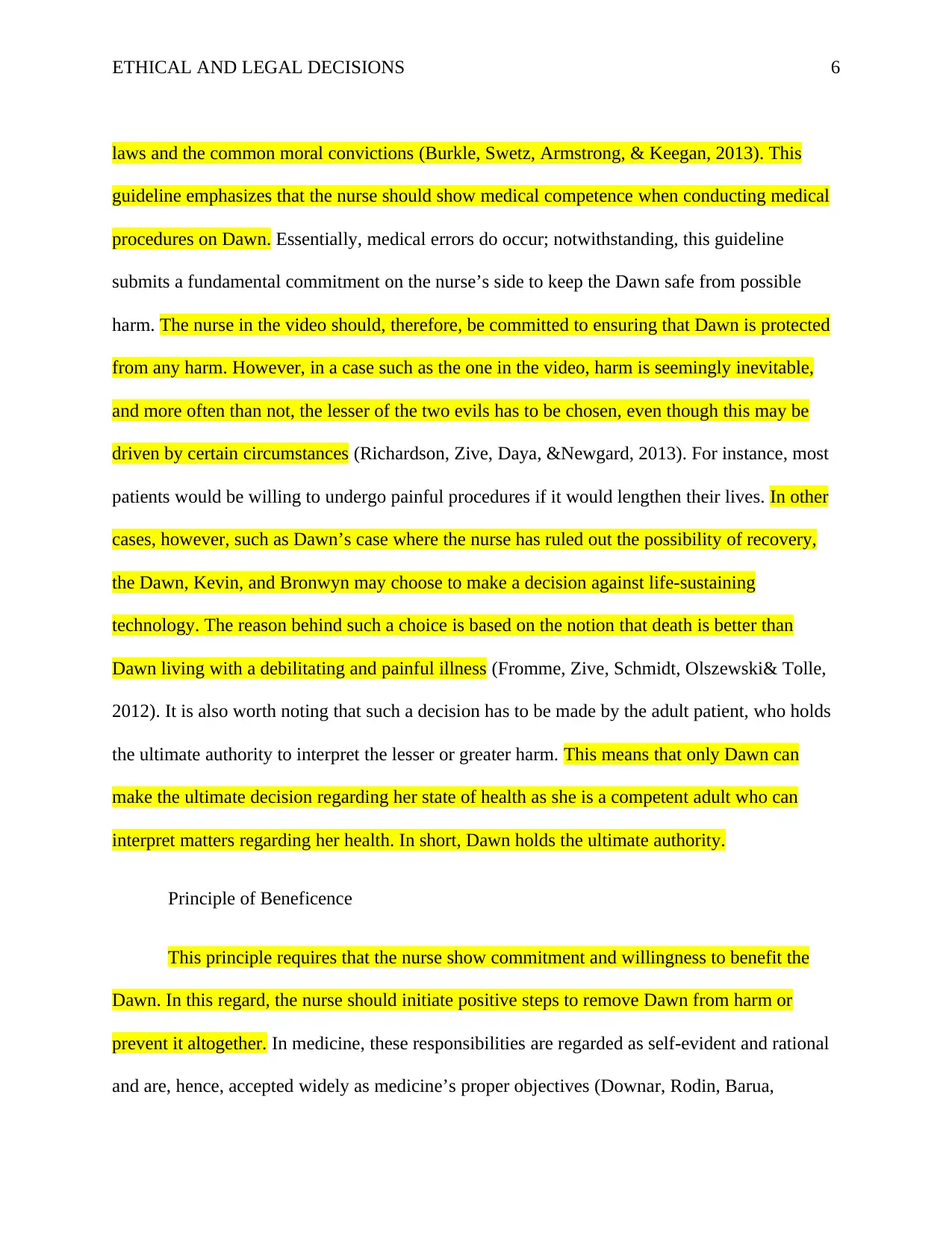
ETHICAL AND LEGAL DECISIONS 6
laws and the common moral convictions (Burkle, Swetz, Armstrong, & Keegan, 2013). This
guideline emphasizes that the nurse should show medical competence when conducting medical
procedures on Dawn. Essentially, medical errors do occur; notwithstanding, this guideline
submits a fundamental commitment on the nurse’s side to keep the Dawn safe from possible
harm. The nurse in the video should, therefore, be committed to ensuring that Dawn is protected
from any harm. However, in a case such as the one in the video, harm is seemingly inevitable,
and more often than not, the lesser of the two evils has to be chosen, even though this may be
driven by certain circumstances (Richardson, Zive, Daya, &Newgard, 2013). For instance, most
patients would be willing to undergo painful procedures if it would lengthen their lives. In other
cases, however, such as Dawn’s case where the nurse has ruled out the possibility of recovery,
the Dawn, Kevin, and Bronwyn may choose to make a decision against life-sustaining
technology. The reason behind such a choice is based on the notion that death is better than
Dawn living with a debilitating and painful illness (Fromme, Zive, Schmidt, Olszewski& Tolle,
2012). It is also worth noting that such a decision has to be made by the adult patient, who holds
the ultimate authority to interpret the lesser or greater harm. This means that only Dawn can
make the ultimate decision regarding her state of health as she is a competent adult who can
interpret matters regarding her health. In short, Dawn holds the ultimate authority.
Principle of Beneficence
This principle requires that the nurse show commitment and willingness to benefit the
Dawn. In this regard, the nurse should initiate positive steps to remove Dawn from harm or
prevent it altogether. In medicine, these responsibilities are regarded as self-evident and rational
and are, hence, accepted widely as medicine’s proper objectives (Downar, Rodin, Barua,
laws and the common moral convictions (Burkle, Swetz, Armstrong, & Keegan, 2013). This
guideline emphasizes that the nurse should show medical competence when conducting medical
procedures on Dawn. Essentially, medical errors do occur; notwithstanding, this guideline
submits a fundamental commitment on the nurse’s side to keep the Dawn safe from possible
harm. The nurse in the video should, therefore, be committed to ensuring that Dawn is protected
from any harm. However, in a case such as the one in the video, harm is seemingly inevitable,
and more often than not, the lesser of the two evils has to be chosen, even though this may be
driven by certain circumstances (Richardson, Zive, Daya, &Newgard, 2013). For instance, most
patients would be willing to undergo painful procedures if it would lengthen their lives. In other
cases, however, such as Dawn’s case where the nurse has ruled out the possibility of recovery,
the Dawn, Kevin, and Bronwyn may choose to make a decision against life-sustaining
technology. The reason behind such a choice is based on the notion that death is better than
Dawn living with a debilitating and painful illness (Fromme, Zive, Schmidt, Olszewski& Tolle,
2012). It is also worth noting that such a decision has to be made by the adult patient, who holds
the ultimate authority to interpret the lesser or greater harm. This means that only Dawn can
make the ultimate decision regarding her state of health as she is a competent adult who can
interpret matters regarding her health. In short, Dawn holds the ultimate authority.
Principle of Beneficence
This principle requires that the nurse show commitment and willingness to benefit the
Dawn. In this regard, the nurse should initiate positive steps to remove Dawn from harm or
prevent it altogether. In medicine, these responsibilities are regarded as self-evident and rational
and are, hence, accepted widely as medicine’s proper objectives (Downar, Rodin, Barua,
⊘ This is a preview!⊘
Do you want full access?
Subscribe today to unlock all pages.

Trusted by 1+ million students worldwide
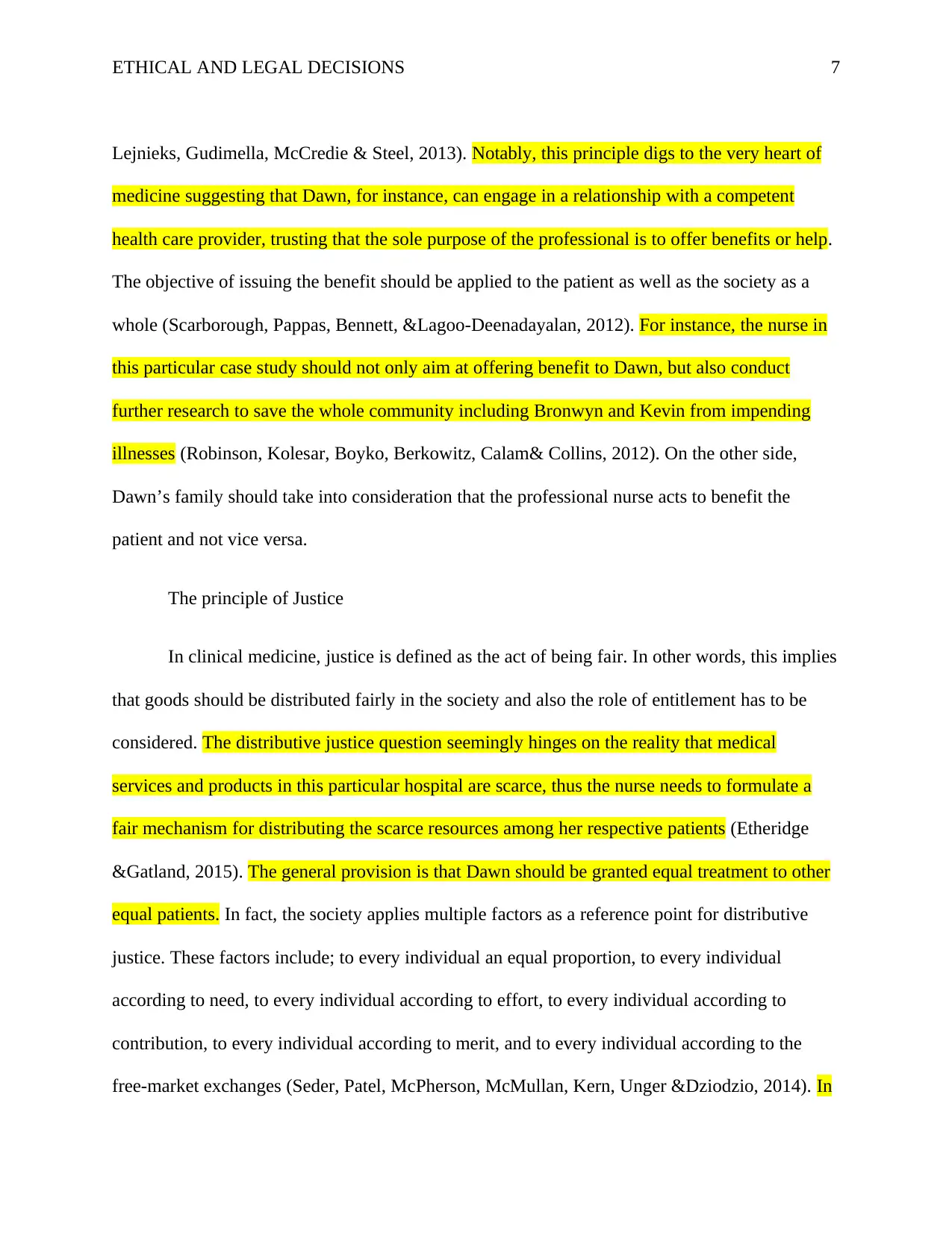
ETHICAL AND LEGAL DECISIONS 7
Lejnieks, Gudimella, McCredie & Steel, 2013). Notably, this principle digs to the very heart of
medicine suggesting that Dawn, for instance, can engage in a relationship with a competent
health care provider, trusting that the sole purpose of the professional is to offer benefits or help.
The objective of issuing the benefit should be applied to the patient as well as the society as a
whole (Scarborough, Pappas, Bennett, &Lagoo-Deenadayalan, 2012). For instance, the nurse in
this particular case study should not only aim at offering benefit to Dawn, but also conduct
further research to save the whole community including Bronwyn and Kevin from impending
illnesses (Robinson, Kolesar, Boyko, Berkowitz, Calam& Collins, 2012). On the other side,
Dawn’s family should take into consideration that the professional nurse acts to benefit the
patient and not vice versa.
The principle of Justice
In clinical medicine, justice is defined as the act of being fair. In other words, this implies
that goods should be distributed fairly in the society and also the role of entitlement has to be
considered. The distributive justice question seemingly hinges on the reality that medical
services and products in this particular hospital are scarce, thus the nurse needs to formulate a
fair mechanism for distributing the scarce resources among her respective patients (Etheridge
&Gatland, 2015). The general provision is that Dawn should be granted equal treatment to other
equal patients. In fact, the society applies multiple factors as a reference point for distributive
justice. These factors include; to every individual an equal proportion, to every individual
according to need, to every individual according to effort, to every individual according to
contribution, to every individual according to merit, and to every individual according to the
free-market exchanges (Seder, Patel, McPherson, McMullan, Kern, Unger &Dziodzio, 2014). In
Lejnieks, Gudimella, McCredie & Steel, 2013). Notably, this principle digs to the very heart of
medicine suggesting that Dawn, for instance, can engage in a relationship with a competent
health care provider, trusting that the sole purpose of the professional is to offer benefits or help.
The objective of issuing the benefit should be applied to the patient as well as the society as a
whole (Scarborough, Pappas, Bennett, &Lagoo-Deenadayalan, 2012). For instance, the nurse in
this particular case study should not only aim at offering benefit to Dawn, but also conduct
further research to save the whole community including Bronwyn and Kevin from impending
illnesses (Robinson, Kolesar, Boyko, Berkowitz, Calam& Collins, 2012). On the other side,
Dawn’s family should take into consideration that the professional nurse acts to benefit the
patient and not vice versa.
The principle of Justice
In clinical medicine, justice is defined as the act of being fair. In other words, this implies
that goods should be distributed fairly in the society and also the role of entitlement has to be
considered. The distributive justice question seemingly hinges on the reality that medical
services and products in this particular hospital are scarce, thus the nurse needs to formulate a
fair mechanism for distributing the scarce resources among her respective patients (Etheridge
&Gatland, 2015). The general provision is that Dawn should be granted equal treatment to other
equal patients. In fact, the society applies multiple factors as a reference point for distributive
justice. These factors include; to every individual an equal proportion, to every individual
according to need, to every individual according to effort, to every individual according to
contribution, to every individual according to merit, and to every individual according to the
free-market exchanges (Seder, Patel, McPherson, McMullan, Kern, Unger &Dziodzio, 2014). In
Paraphrase This Document
Need a fresh take? Get an instant paraphrase of this document with our AI Paraphraser
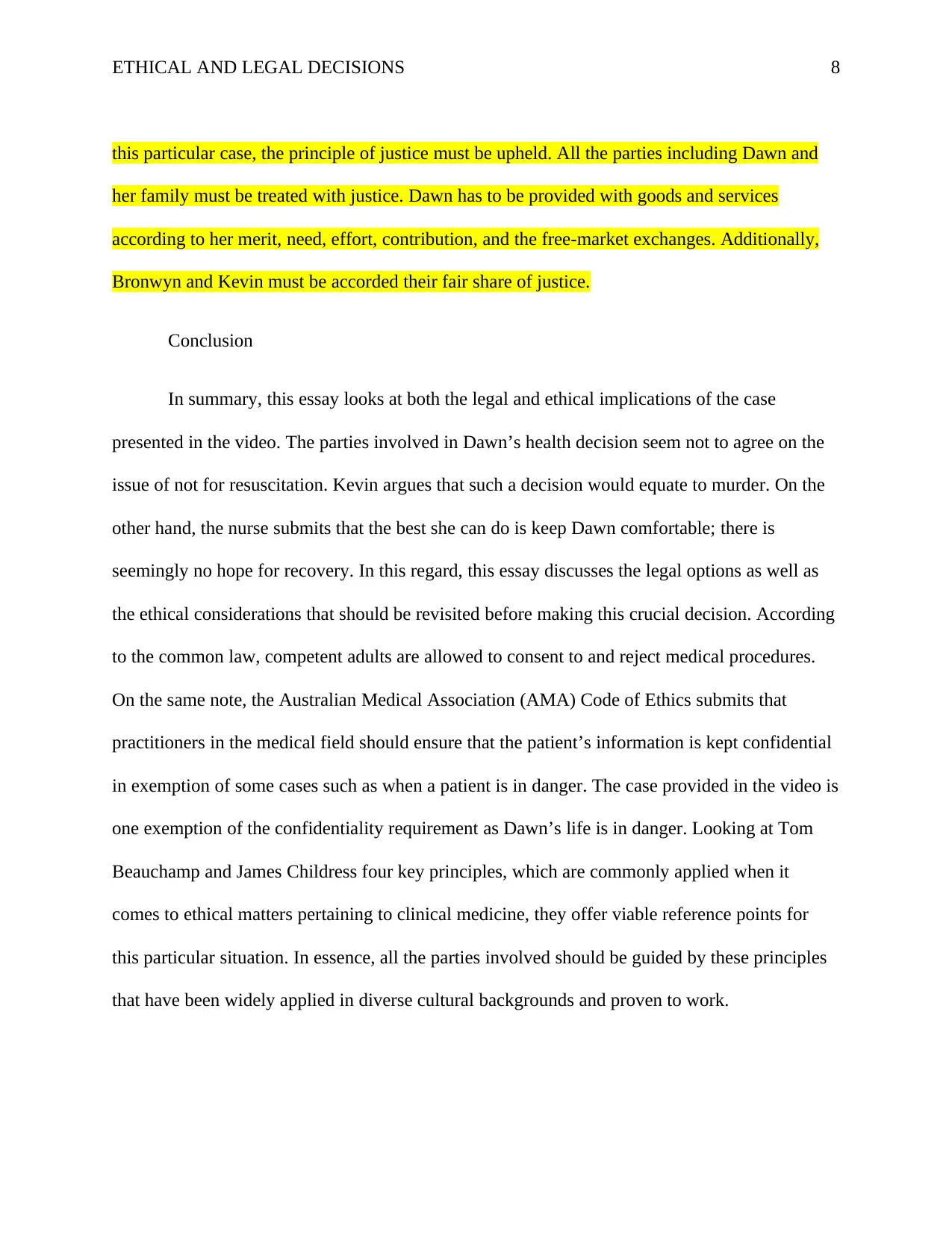
ETHICAL AND LEGAL DECISIONS 8
this particular case, the principle of justice must be upheld. All the parties including Dawn and
her family must be treated with justice. Dawn has to be provided with goods and services
according to her merit, need, effort, contribution, and the free-market exchanges. Additionally,
Bronwyn and Kevin must be accorded their fair share of justice.
Conclusion
In summary, this essay looks at both the legal and ethical implications of the case
presented in the video. The parties involved in Dawn’s health decision seem not to agree on the
issue of not for resuscitation. Kevin argues that such a decision would equate to murder. On the
other hand, the nurse submits that the best she can do is keep Dawn comfortable; there is
seemingly no hope for recovery. In this regard, this essay discusses the legal options as well as
the ethical considerations that should be revisited before making this crucial decision. According
to the common law, competent adults are allowed to consent to and reject medical procedures.
On the same note, the Australian Medical Association (AMA) Code of Ethics submits that
practitioners in the medical field should ensure that the patient’s information is kept confidential
in exemption of some cases such as when a patient is in danger. The case provided in the video is
one exemption of the confidentiality requirement as Dawn’s life is in danger. Looking at Tom
Beauchamp and James Childress four key principles, which are commonly applied when it
comes to ethical matters pertaining to clinical medicine, they offer viable reference points for
this particular situation. In essence, all the parties involved should be guided by these principles
that have been widely applied in diverse cultural backgrounds and proven to work.
this particular case, the principle of justice must be upheld. All the parties including Dawn and
her family must be treated with justice. Dawn has to be provided with goods and services
according to her merit, need, effort, contribution, and the free-market exchanges. Additionally,
Bronwyn and Kevin must be accorded their fair share of justice.
Conclusion
In summary, this essay looks at both the legal and ethical implications of the case
presented in the video. The parties involved in Dawn’s health decision seem not to agree on the
issue of not for resuscitation. Kevin argues that such a decision would equate to murder. On the
other hand, the nurse submits that the best she can do is keep Dawn comfortable; there is
seemingly no hope for recovery. In this regard, this essay discusses the legal options as well as
the ethical considerations that should be revisited before making this crucial decision. According
to the common law, competent adults are allowed to consent to and reject medical procedures.
On the same note, the Australian Medical Association (AMA) Code of Ethics submits that
practitioners in the medical field should ensure that the patient’s information is kept confidential
in exemption of some cases such as when a patient is in danger. The case provided in the video is
one exemption of the confidentiality requirement as Dawn’s life is in danger. Looking at Tom
Beauchamp and James Childress four key principles, which are commonly applied when it
comes to ethical matters pertaining to clinical medicine, they offer viable reference points for
this particular situation. In essence, all the parties involved should be guided by these principles
that have been widely applied in diverse cultural backgrounds and proven to work.
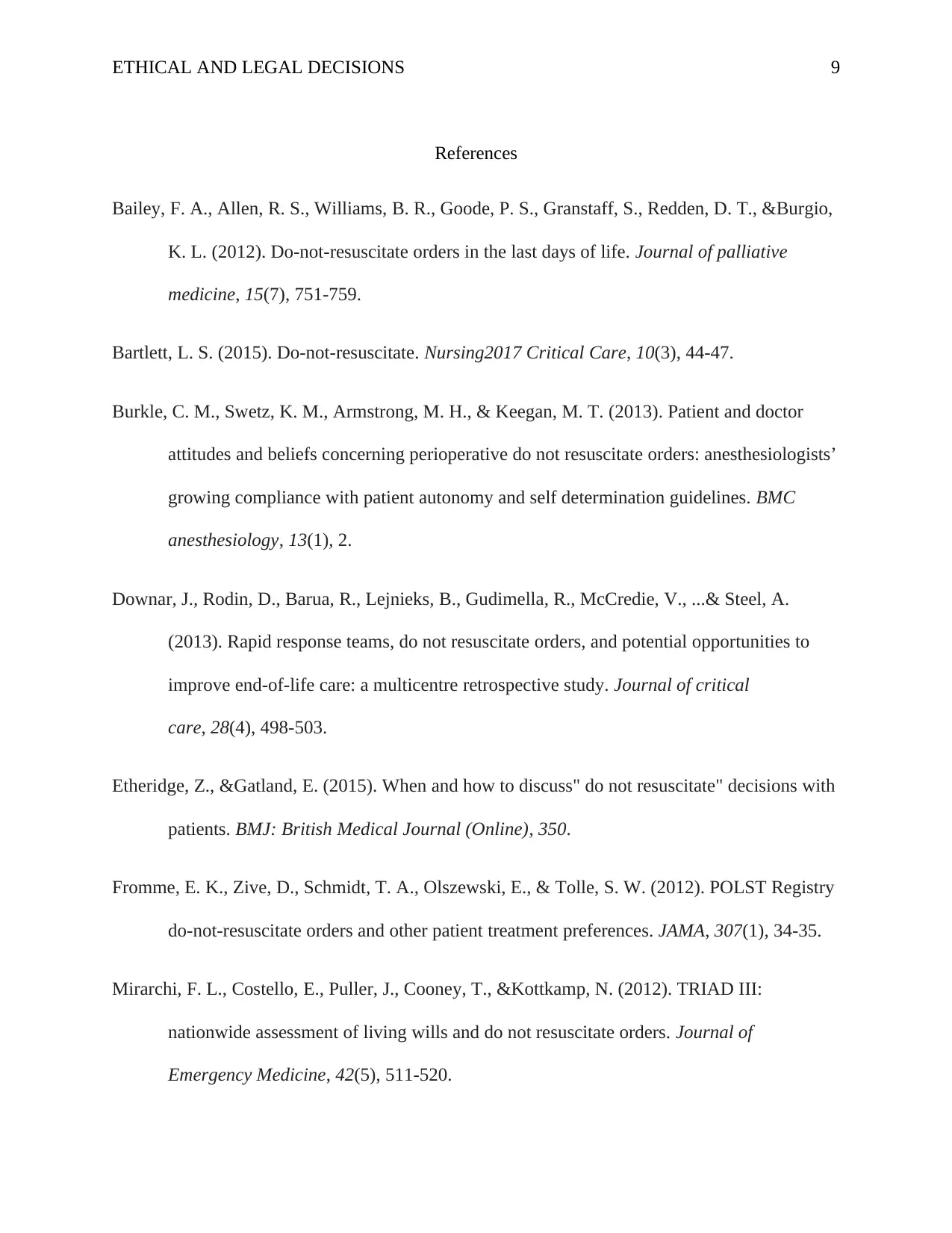
ETHICAL AND LEGAL DECISIONS 9
References
Bailey, F. A., Allen, R. S., Williams, B. R., Goode, P. S., Granstaff, S., Redden, D. T., &Burgio,
K. L. (2012). Do-not-resuscitate orders in the last days of life. Journal of palliative
medicine, 15(7), 751-759.
Bartlett, L. S. (2015). Do-not-resuscitate. Nursing2017 Critical Care, 10(3), 44-47.
Burkle, C. M., Swetz, K. M., Armstrong, M. H., & Keegan, M. T. (2013). Patient and doctor
attitudes and beliefs concerning perioperative do not resuscitate orders: anesthesiologists’
growing compliance with patient autonomy and self determination guidelines. BMC
anesthesiology, 13(1), 2.
Downar, J., Rodin, D., Barua, R., Lejnieks, B., Gudimella, R., McCredie, V., ...& Steel, A.
(2013). Rapid response teams, do not resuscitate orders, and potential opportunities to
improve end-of-life care: a multicentre retrospective study. Journal of critical
care, 28(4), 498-503.
Etheridge, Z., &Gatland, E. (2015). When and how to discuss" do not resuscitate" decisions with
patients. BMJ: British Medical Journal (Online), 350.
Fromme, E. K., Zive, D., Schmidt, T. A., Olszewski, E., & Tolle, S. W. (2012). POLST Registry
do-not-resuscitate orders and other patient treatment preferences. JAMA, 307(1), 34-35.
Mirarchi, F. L., Costello, E., Puller, J., Cooney, T., &Kottkamp, N. (2012). TRIAD III:
nationwide assessment of living wills and do not resuscitate orders. Journal of
Emergency Medicine, 42(5), 511-520.
References
Bailey, F. A., Allen, R. S., Williams, B. R., Goode, P. S., Granstaff, S., Redden, D. T., &Burgio,
K. L. (2012). Do-not-resuscitate orders in the last days of life. Journal of palliative
medicine, 15(7), 751-759.
Bartlett, L. S. (2015). Do-not-resuscitate. Nursing2017 Critical Care, 10(3), 44-47.
Burkle, C. M., Swetz, K. M., Armstrong, M. H., & Keegan, M. T. (2013). Patient and doctor
attitudes and beliefs concerning perioperative do not resuscitate orders: anesthesiologists’
growing compliance with patient autonomy and self determination guidelines. BMC
anesthesiology, 13(1), 2.
Downar, J., Rodin, D., Barua, R., Lejnieks, B., Gudimella, R., McCredie, V., ...& Steel, A.
(2013). Rapid response teams, do not resuscitate orders, and potential opportunities to
improve end-of-life care: a multicentre retrospective study. Journal of critical
care, 28(4), 498-503.
Etheridge, Z., &Gatland, E. (2015). When and how to discuss" do not resuscitate" decisions with
patients. BMJ: British Medical Journal (Online), 350.
Fromme, E. K., Zive, D., Schmidt, T. A., Olszewski, E., & Tolle, S. W. (2012). POLST Registry
do-not-resuscitate orders and other patient treatment preferences. JAMA, 307(1), 34-35.
Mirarchi, F. L., Costello, E., Puller, J., Cooney, T., &Kottkamp, N. (2012). TRIAD III:
nationwide assessment of living wills and do not resuscitate orders. Journal of
Emergency Medicine, 42(5), 511-520.
⊘ This is a preview!⊘
Do you want full access?
Subscribe today to unlock all pages.

Trusted by 1+ million students worldwide
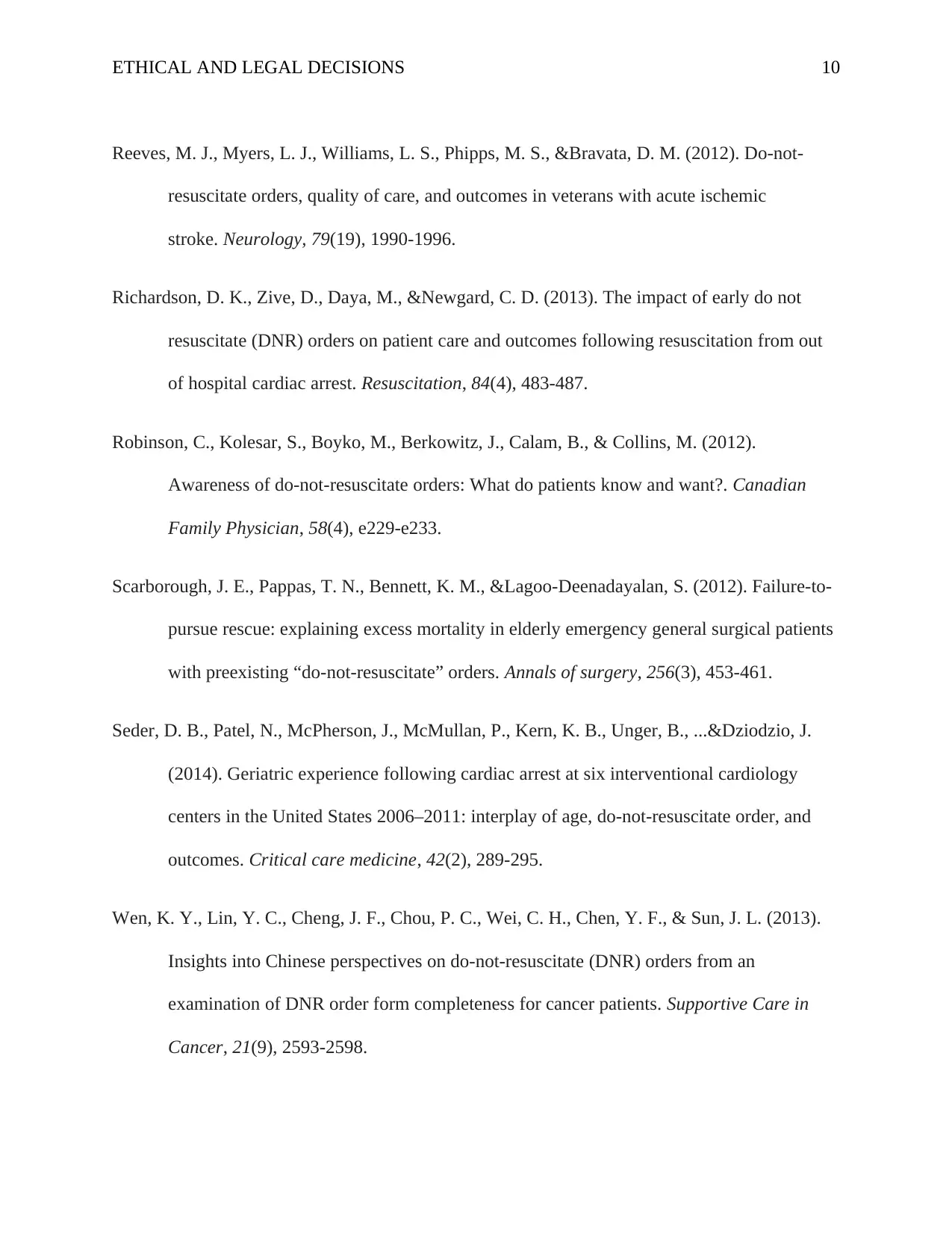
ETHICAL AND LEGAL DECISIONS 10
Reeves, M. J., Myers, L. J., Williams, L. S., Phipps, M. S., &Bravata, D. M. (2012). Do-not-
resuscitate orders, quality of care, and outcomes in veterans with acute ischemic
stroke. Neurology, 79(19), 1990-1996.
Richardson, D. K., Zive, D., Daya, M., &Newgard, C. D. (2013). The impact of early do not
resuscitate (DNR) orders on patient care and outcomes following resuscitation from out
of hospital cardiac arrest. Resuscitation, 84(4), 483-487.
Robinson, C., Kolesar, S., Boyko, M., Berkowitz, J., Calam, B., & Collins, M. (2012).
Awareness of do-not-resuscitate orders: What do patients know and want?. Canadian
Family Physician, 58(4), e229-e233.
Scarborough, J. E., Pappas, T. N., Bennett, K. M., &Lagoo-Deenadayalan, S. (2012). Failure-to-
pursue rescue: explaining excess mortality in elderly emergency general surgical patients
with preexisting “do-not-resuscitate” orders. Annals of surgery, 256(3), 453-461.
Seder, D. B., Patel, N., McPherson, J., McMullan, P., Kern, K. B., Unger, B., ...&Dziodzio, J.
(2014). Geriatric experience following cardiac arrest at six interventional cardiology
centers in the United States 2006–2011: interplay of age, do-not-resuscitate order, and
outcomes. Critical care medicine, 42(2), 289-295.
Wen, K. Y., Lin, Y. C., Cheng, J. F., Chou, P. C., Wei, C. H., Chen, Y. F., & Sun, J. L. (2013).
Insights into Chinese perspectives on do-not-resuscitate (DNR) orders from an
examination of DNR order form completeness for cancer patients. Supportive Care in
Cancer, 21(9), 2593-2598.
Reeves, M. J., Myers, L. J., Williams, L. S., Phipps, M. S., &Bravata, D. M. (2012). Do-not-
resuscitate orders, quality of care, and outcomes in veterans with acute ischemic
stroke. Neurology, 79(19), 1990-1996.
Richardson, D. K., Zive, D., Daya, M., &Newgard, C. D. (2013). The impact of early do not
resuscitate (DNR) orders on patient care and outcomes following resuscitation from out
of hospital cardiac arrest. Resuscitation, 84(4), 483-487.
Robinson, C., Kolesar, S., Boyko, M., Berkowitz, J., Calam, B., & Collins, M. (2012).
Awareness of do-not-resuscitate orders: What do patients know and want?. Canadian
Family Physician, 58(4), e229-e233.
Scarborough, J. E., Pappas, T. N., Bennett, K. M., &Lagoo-Deenadayalan, S. (2012). Failure-to-
pursue rescue: explaining excess mortality in elderly emergency general surgical patients
with preexisting “do-not-resuscitate” orders. Annals of surgery, 256(3), 453-461.
Seder, D. B., Patel, N., McPherson, J., McMullan, P., Kern, K. B., Unger, B., ...&Dziodzio, J.
(2014). Geriatric experience following cardiac arrest at six interventional cardiology
centers in the United States 2006–2011: interplay of age, do-not-resuscitate order, and
outcomes. Critical care medicine, 42(2), 289-295.
Wen, K. Y., Lin, Y. C., Cheng, J. F., Chou, P. C., Wei, C. H., Chen, Y. F., & Sun, J. L. (2013).
Insights into Chinese perspectives on do-not-resuscitate (DNR) orders from an
examination of DNR order form completeness for cancer patients. Supportive Care in
Cancer, 21(9), 2593-2598.
Paraphrase This Document
Need a fresh take? Get an instant paraphrase of this document with our AI Paraphraser
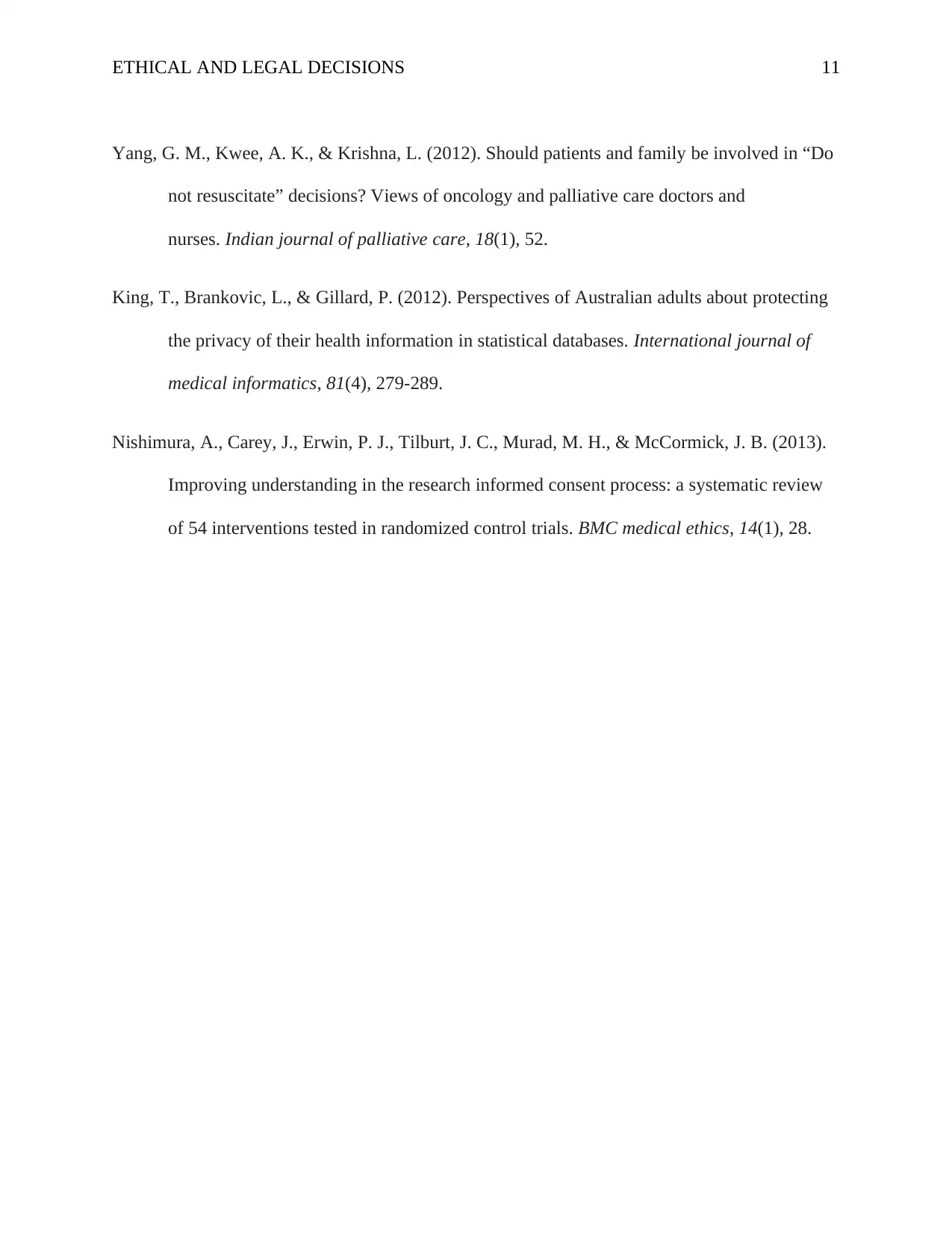
ETHICAL AND LEGAL DECISIONS 11
Yang, G. M., Kwee, A. K., & Krishna, L. (2012). Should patients and family be involved in “Do
not resuscitate” decisions? Views of oncology and palliative care doctors and
nurses. Indian journal of palliative care, 18(1), 52.
King, T., Brankovic, L., & Gillard, P. (2012). Perspectives of Australian adults about protecting
the privacy of their health information in statistical databases. International journal of
medical informatics, 81(4), 279-289.
Nishimura, A., Carey, J., Erwin, P. J., Tilburt, J. C., Murad, M. H., & McCormick, J. B. (2013).
Improving understanding in the research informed consent process: a systematic review
of 54 interventions tested in randomized control trials. BMC medical ethics, 14(1), 28.
Yang, G. M., Kwee, A. K., & Krishna, L. (2012). Should patients and family be involved in “Do
not resuscitate” decisions? Views of oncology and palliative care doctors and
nurses. Indian journal of palliative care, 18(1), 52.
King, T., Brankovic, L., & Gillard, P. (2012). Perspectives of Australian adults about protecting
the privacy of their health information in statistical databases. International journal of
medical informatics, 81(4), 279-289.
Nishimura, A., Carey, J., Erwin, P. J., Tilburt, J. C., Murad, M. H., & McCormick, J. B. (2013).
Improving understanding in the research informed consent process: a systematic review
of 54 interventions tested in randomized control trials. BMC medical ethics, 14(1), 28.
1 out of 11
Related Documents
Your All-in-One AI-Powered Toolkit for Academic Success.
+13062052269
info@desklib.com
Available 24*7 on WhatsApp / Email
![[object Object]](/_next/static/media/star-bottom.7253800d.svg)
Unlock your academic potential
Copyright © 2020–2025 A2Z Services. All Rights Reserved. Developed and managed by ZUCOL.



